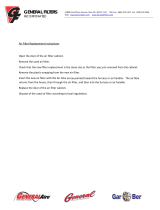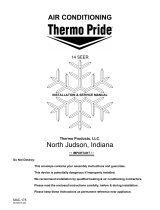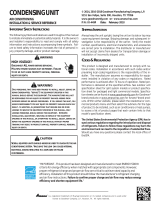
6 18-GL07D1-4
2GN SPLIT INSTALLER’S GUIDE
Air Coil Location
Refer to the air handler manufacturer’s instructions for the
blower coil unit for details on installing the air handling portion
of the system.
Condensate Drain
Follow the blower coil manufacturer’s instructions.
Duct System
All blower coil units/air coils must be installed as specifi ed
by the manufacturer’s installation instructions; however, the
following recommendations should be considered to minimize
noise and service problems.
An air fi lter must always be installed upstream of the air coil on
the return air side of the air handler or furnace. If there is limited
access to the fi lter rack for normal maintenance, it is suggested
that a return air fi lter grill be installed. Be sure that the return
duct is properly installed and free of leaks to prevent dirt and
debris from bypassing the fi lter and plugging the air coil.
In applications using galvanized metal ductwork, a fl exible
duct connector is recommended on both the supply and return
air plenums to minimize vibration from the blower. To maximize
sound attenuation of the unit blower, the supply and return
plenums should include an internal duct liner of 1-inch thick
glass fi ber or be constructed of ductboard. Insulation is usually
not installed in the supply branch ducts. Ducts in unconditioned
areas should be wrapped with a minimum of 1-inch duct
insulation. Application of the unit to uninsulated ductwork in
an unconditioned space is not recommended as the unit’s
performance will be adversely affected. If the air handler is
connected to existing ductwork, a previous check should have
been made to assure that the duct system has the capacity
to handle the air required for the unit application. If ducting is
too small, as in replacement of heating only systems, larger
ductwork should be installed. All existing ductwork should be
checked for leaks and repairs made accordingly. The duct
systems and diffusers should be sized to handle the design
airfl ow quietly. If air noise or excessive airfl ow is a problem,
the blower speed can be changed to a lower speed to reduce
airfl ow. This will reduce the performance of the unit slightly in
heating; however, it will increase the temperature rise across
the air coil. Airfl ow must still meet minimum requirements.
Equipment Selection
The following guidelines should be used when mating a 2GN
Series Split to an air handler/coil.
• Select R-410A components only.
• Match the air handler to the air handler coil data
table.
• Indoor matching adjustable TXV is factory installed
on every coil. Fixed orifi ce or cap tube systems
should not be used. TAMG air handlers have
electronic expansion valves (EEV).
• Minimum of two (2) stage cooling blower required.
Variable speed ECM blower recommended.
GENERAL INSTALLATION
INFORMATION
WARNING!
Safety Considerations
Before performing service or maintenance
operations on a system, turn off main power
switches to the indoor unit. If applicable, turn
off the accessory heater power switch. Electrical
shock could cause personal injury.
Installing and servicing heating and air conditioning equipment
can be hazardous due to system pressure and electrical
components. Only trained and qualifi ed service personnel
should install, repair or service heating and air conditioning
equipment. Untrained personnel can perform the basic
maintenance functions of cleaning coils and cleaning and
replacing fi lters. All other operations should be performed by
trained service personnel. When working on heating and air
conditioning equipment, observe precautions in the literature,
tags and labels attached to the unit and other safety precautions
that may apply, such as the following safety measures:
• Follow all safety codes.
• Wear safety glasses and work gloves.
• Use a quenching cloth for brazing operations.
• Have a fi re extinguisher available for all brazing
operations.
Moving and Storage
Move units in the normal “up” orientation. Units may be moved
and stored per the information on the packaging. Do not stack
more than three units in total height. Do not attempt to move
units while stacked. When the equipment is received, all items
should be carefully checked against the bill of lading to be
sure all crates and cartons have been received. Examine units
for shipping damage, removing the units from the packaging
if necessary. Units in question should also be internally
inspected. If any damage is noted, the carrier should make
the proper notation on the delivery receipt, acknowledging the
damage.
Unit Location
Locate the unit in an indoor area that allows for easy removal
of the access panels. Location should have enough space for
service personnel to perform maintenance or repair. Provide
suffi cient room to make water, electrical and refrigerant line
connections. Any access panel screws that would be diffi cult
to remove after the unit is installed should be removed prior to
setting the unit. Care should be taken when units are located
in unconditioned spaces to prevent damage from frozen
water lines and excessive heat that could damage electrical
components. Note: Prior to setting the unit in place, remove
and discard the compressor shipping bolt located at the front
of the compressor mounting bracket.
























